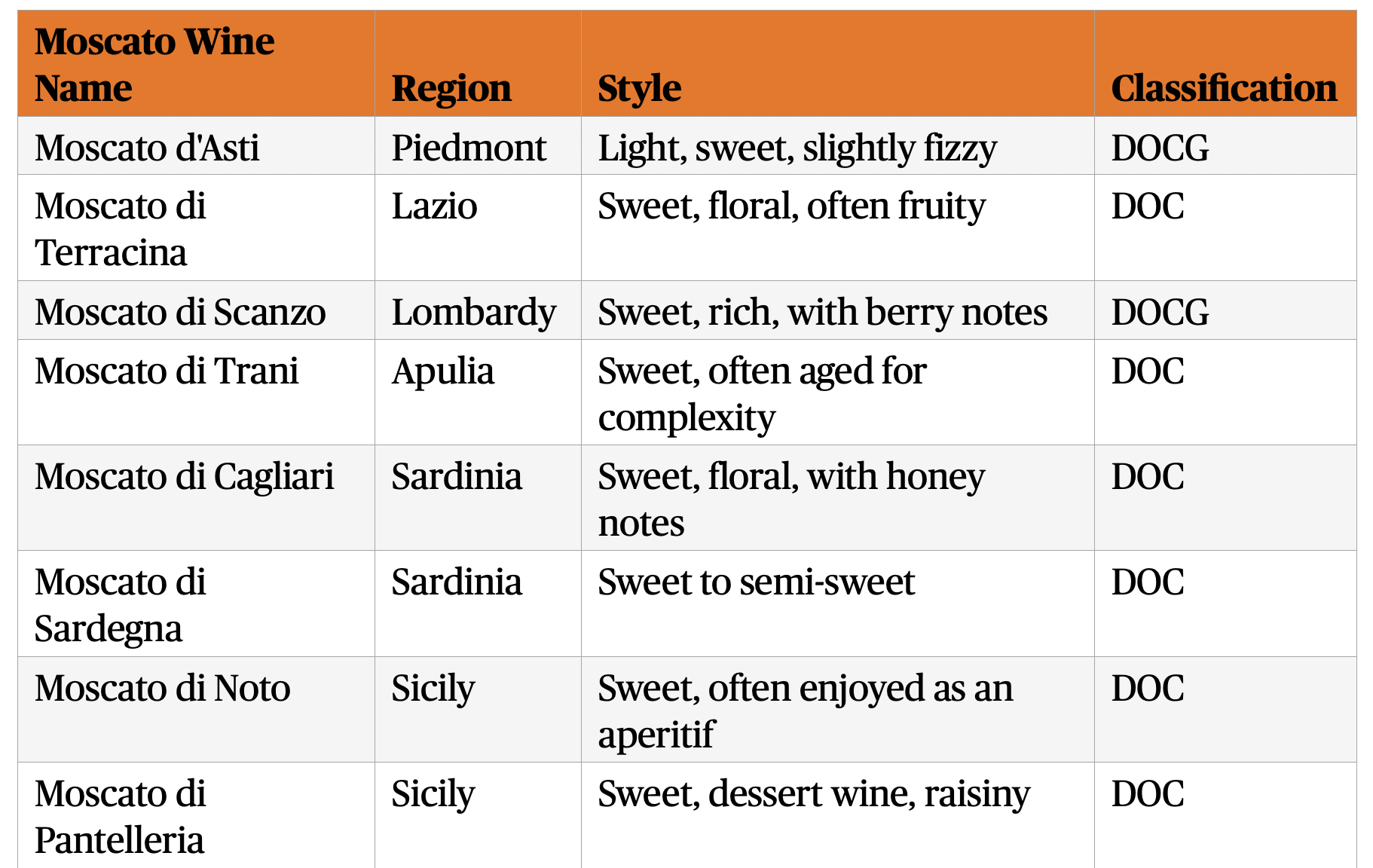Moscato Wine Magic: Your Grape Guide to Sipping Sweetly
Hey there, wine lovers!
Are you ready for another fun journey into the world of wine? This time, we're chatting about Muscat ( Moscato ). Whether you've tasted it before or not, I promise we're in for a sweet time!
Moscato isn't just any grape. It's a real crowd-pleaser, loved all around the world. Born in Greece or Italy, Moscato has traveled far and wide, popping up under different names and in various tasty styles.
In this blog, we'll dig into what makes Moscato so special. We will learn, laugh, and maybe even develop a new favorite wine. After all, drinking wine is fun, but it's even better when you know a little about what's in your glass.
So, whether you're a seasoned wine drinker, a casual sipper, or wine-curious, let's embark on this adventure together! I'm thrilled to be your guide as we dive into the sweet world of Moscato. Here's to great wine and even better times.
Meet Moscato: The Basics and Beyond
You've probably noticed how Moscato lights up any room it enters, or in this case, any glass it fills. Light-bodied and exquisitely sweet, Moscato has been a rising star in the wine world, gaining quite a fan base.
Its refreshing taste, often described as a burst of summer in your mouth, is a definite crowd-pleaser. Plus, with a typically lower alcohol content, it's an ideal choice for relaxed, easy sipping.
You might initially associate sweet wine with dessert - an understandable assumption. But Moscato is a rule-breaker, pairing just as beautifully with a host of dinner dishes. Got some spicy Asian cuisine or tangy, salty cheeses on your plate? Moscato complements these perfectly, balancing and contrasting flavors in a delightful dance.
Moreover, Moscato doesn't demand a deep dive into your wallet. It's an affordable luxury, proving that fantastic wine experiences don't always come with a hefty price tag.
So, what gives Moscato its unique taste? The secret lies in the grapes. Each variety is made from the versatile Muscat family of grapes, adding a distinct touch to Moscato's flavors and aromas.
In essence, Moscato is joy captured in a bottle: it's versatile, delectable, and appeals to everyone.
Historical Grape-ness: Moscato's Roots in Piemonte
Let's turn back the clock and discover where Moscato first burst onto the scene in Piemonte. Picture this: vineyards tucked into the rolling hills of Piedmont in Italy. This region has been Moscato's home for hundreds of years, making it one of the oldest grapes.
The credit for its soaring popularity in Piedmont goes to Duke Emanuele Filiberto of Savoy. His decree limiting imports in favor of local production was the turning point for Moscato. This was when Moscato truly took center stage - it started popping up in wine cellars and on dinner tables all across the region. Critics and the public loved it, and Moscato was well on becoming a superstar.
By the end of the 1700s, the esteemed Agricultural Society of Turin even hailed it as a Piedmontese variety that could produce some of the region's most prestigious wines. Talk about high praise!
Fast forward to today, and Moscato d’Asti - a sweet wine made from Moscato - is the world's most widely consumed sweet wine. This celebrated variant was awarded the Denomination of Controlled and Guaranteed Origins (DOCG) in February 1994, a testament to its quality and heritage.
Italian Moscato Wines
In the world of Italian Moscato wines, diversity is key. Each region puts its twist on this delightful varietal, from the light and fizzy Moscato d'Asti of Piedmont to the sweet and complex Moscato di Trani from Apulia. While all these wines fall under the 'Moscato umbrella, they offer different styles, flavors, and aromatic profiles thanks to their unique geographic origins and production methods. Some, like Moscato d'Asti, have even earned the prestigious DOCG status, highlighting their exceptional quality. Let's uncork the details with the chart below.
Moscato by Any Other Name: Variations Across the Globe
Now, let's get into Moscato's international aliases. Picture a globe-trotting super-spy, assuming different identities in different parts of the world - that's our Moscato!
In France, the noblest sort of Muscat is known as Muscat Blanc à Petits Grains, characterized by its small, pale yellow-skinned berries. Over in Spain, it goes by Moscatel de Grano Menudo. When you wander to Italy, you might hear it being referred to as Moscato d'Asti, Moscato di Canelli, or simply Moscato Bianco. Other monikers include Muscat of Frontignan, Muscat Lunel, Muskateller, Moschato Spinas, or Muscat of Spina.
What's special about this type of Moscato is its finesse. It produces wines with a delightful, pure, floral hint of grapiness. The grapes can sometimes have a golden hue, leading to names like Gelber Muskateller or Moscato Giallo.
But that's not all! Moscato's got some colorful cousins, too, with grape skins ranging from pink to red and even pale brown. One of the most notable is the Brown Muscat, a deep-colored variant making waves in Australia. Some of the finest Muscat wines come from this variant, and trust me, they're worth seeking out.
So, whether you're sipping on a Muscat Blanc à Petits Grains in France, a Moscato Bianco in Italy, or a Brown Muscat in Australia, remember: they're all family. They have different names and places, but all share that unique Moscato magic we know and love.
Ready to move on styles? Let's go!
Styles and Swirls: Understanding the Different Types of Moscato Wine
Now that we've journeyed through Moscato's history and the many names it goes by let's explore the wonderful world of Moscato styles. Like an artist with a palette, Moscato offers an array of unique, colorful expressions.
First up, we have Sparkling and Semi-Sparkling Moscato. These wines are the life of the party, loved for their bubbly personality. They're often served as aperitifs or partnered with desserts. Moscato d'Asti is a popular semi-sparkling style in Italy, while Asti Spumante brings all the sparkle.
Then there's Still Moscato, the quiet cousin. It's a non-sparkling wine, often made in a dry style, and a less common sighting than its bubbly counterpart. But remember, it's just part of the family and brings charm.
Next, meet Pink Moscato. This rosé wine made from Moscato grapes is as sweet and fruity as it sounds. It's like sipping on a summer sunset.
Say hello to Red Moscato Black Muscat if you prefer something darker. It's like the sophisticated, mysterious character in a novel, turning heads with its deep red color and sweet flavor profile.
Last but definitely not least, we have Moscato Dessert Wines. These sweet wines are like the cherry on top of a perfect meal. Made from Muscat grapes, they're often served with desserts and have low alcohol content.
One Moscato wine in the spotlight is the 2016 ViNO Moscato. It's like a symphony in a bottle, harmoniously balancing bright, tart flavors with notes of orange blossom, lychee, and lime.
The best part? Moscato wine is generally an affordable delight, meaning it's accessible to everyone. So, whichever style tickles your fancy, a Moscato awaits you.
But how does Moscato taste? Let's dive into its flavor profile next.
Sweet Symphony: Unveiling the Flavors of Moscato
Now, get ready to dive into the flavor profile of Moscato, the sweet and luscious wine that has won hearts worldwide. It's like biting into a fresh, ripe fruit on a sunny day - pure, delightful, and oh-so-satisfying.
Moscato dances on your palate with notes of succulent peaches, fragrant orange blossom, exotic lychee, and zesty lime. With medium to low acidity, it's like a smooth, deep melody that keeps you wanting more.
Pairing Moscato is like finding the perfect dance partner. Because it's sweet, it takes a liking to foods with contrasting flavor profiles - think spicy, sour, salty, or bitter. It's like the yin to their yang, creating a harmonious balance that's pure magic.
Moscato's versatility shines when it comes to food pairing. From spicy Asian cuisine and salty cheeses to your favorite desserts, it can make a meal memorable. But don't stop there - Moscato also loves breakfast! Pancakes, waffles, fruit salads - you name it, Moscato's there to make your mornings extra special.
And if you're into spice, Moscato is your wine. Moscato's sweetness can balance the heat from ingredients like ginger, cinnamon, and hot chili peppers. It's like a soothing breeze on a hot day.
The best part? This flavor-packed adventure doesn't have to break the bank. Moscato wine is generally considered an affordable indulgence, making it a delicious discovery for all.
The next section'll discuss how to properly store and serve your Moscato. Excited? Let's go!
Storing & Serving Moscato: Keep It Cool, Make It Shine
How to Store Moscato Wine:
Find a Cool Spot: Keep your Moscato in a place that's cooler than your average room, ideally below 70°F.
For Long-Term Storage: If you're considering keeping it for a long time, you'll want to ensure it stays at an even cooler 50-59°F. This keeps the wine tasting its best over time.
Short-Term in the Fridge: If you plan to drink it soon, the fridge is fine for a few months. But it's not the best choice for keeping wine longer than that.
How to Serve Moscato Wine:
Chill It First: Moscato wines taste better when cold, except for the sweet ones. It makes them extra refreshing!
But Not Too Cold: Be careful not to make it chilly, like below 43°F. That's too cold, and you won't be able to taste all the good flavors.
In a nutshell, Moscato isn't just a one-trick pony; it comes in various styles that can suit almost any palate. Whether you love the effervescent charm of Moscato d'Asti or the laid-back sweetness of a White Moscato, there's something in the Moscato world for you. So why limit yourself? Explore these styles and find your Moscato match.
Cheers
Alper




